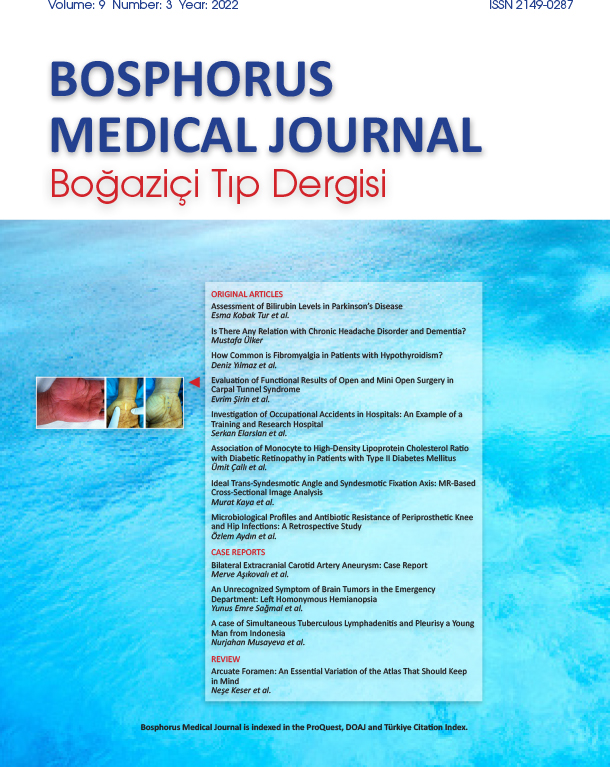Volume: 2 Issue: 3 - 2015
| ORIGINAL RESEARCH | |
| 1. | Integrated Pulmonary Index in Endoscopic Procedures on Sedation Güldem Turan, Berna Ayanoğlu Taş, Öznur Demiroluk, Arzu Yıldırım Ar, Firdevs Karadoğan, Nuriye Esen Bulut, Nur Akgün Pages 85 - 88 INTRODUCTION: In the endoscopic procedures, monitorization of respiratory parameters is important as well as hemodynamic parameters. As the area which is used by the operator and the airway controlled by the anesthetist particularly are in a common location in gastroscopy, observation of the apnea which might take place due to sedation is highly important. Integrated Pulmonary Index (IPI) algorithm analyses four respiratory parameters [end-tidal CO2 (ETCO2), respiratory rate (RR), peripheral pulse rate (PR) and SpO2 values] to a single value that represents the respiratory profile as real time continue measurements. IPI leads the assessment of the respiratory condition of the patient and whether any intervention is required. METHODS: In our study ETCO2 ve RR was monitorized via nasal probe of caphnography monitor (Capnostrem 20p Covidien) and SPO2, PR was monitorized via finger probe in 30 patients who had been subjected to sedation for gastroscopy colonoscopy. The IPI value and ETCO2, SPO2, PR, RR as well as observed apnea and mask ventilation indications were all discussed. RESULTS: Clinical observations, capnography monitorization values and IPI values were similar for 25 patients. SPO2 value was within normal limits in 3 of the 5 patients whose IPI values had been low. DISCUSSION AND CONCLUSION: While SPO2 was normal in 3 of 5 patients who had been observed to have respiratory deficiency, IPI value was low (1-3). IPI score, by way of giving an early warning, is a monitorization method which helps clinician to ensure patient safety. |
| 2. | Glucose Variability And Mean Platelet Volume Ali Özdemir, Yaşar Sertbaş, Ayşegül Dalbeler, Kerem Abacar, Abdurrahman Yiğit, Nalan Okuroğlu, Seda Sancak Pages 89 - 93 INTRODUCTION: Both glucose variability (GV) and increased mean platelet volume (MPV) have been linked to increased cardiovascular complications in patients with diabetes mellitus (DM). We investigated the relationship between these two variables in patients with type 2 DM. METHODS: A total of 100 patients (54 women, the mean age of 59.59±9.12 years) with type 2 DM were recruited in the study. All patients measured the blood glucose on successive two days at home by self-monitoring of blood glucose (SMBG). Seven points SBGM data were used for GV formulas. Intra-day GV with standard deviation (SD) and coefficient of variation (CV), day-today GV with mean of daily differences (MODD) was assessed. MPV values derived from automated cell counting on the third day when collecting the SMBG results. Also; total cholesterol, high and low-density cholesterols, triglyceride and hemoglobin A1C (HbA1C) were measured. RESULTS: There were no statistically significantly differences between the MPV values of patients with lower and upper quartiles for SD and CV (8.26±1.18 vs 8.15±1.26, p>0.05, 8.2±1.21 vs 8.39± 1.1, p>0.05, respectively), and also with the lower and upper quartiles for MODD (8.01±0.97 vs 8.39±1.3, p>0.05). No correlation found between MPV and HbA1c and lipid parameters. There were no significantly differences for MPV values between patients with coronary ischemia, diabetic retinopathy, neuropathy, nephropathy and those without these complications (8.20±1.12 vs 7.78±1.09, p>0.05; 8.25±1.18 vs 8.12±1.11, p>0.05; 8.23±1.08 vs 8.05±1.14, p>0.05; 7.99±1.25 vs 8.11±1.09, p>0.05; respectively). DISCUSSION AND CONCLUSION: Glucose variability does not affect the mean platelet volume. |
| 3. | Patient Controlled Regional Analgesia After Inguinal Hernia Repair Ceren Şanlı Karip, Bora Karip, Fatma Nur Akgün, Berna Ayanoğlu Taş, Mehmet Okuducu, Timuçin Aydın, Kemal Memişoğlu Pages 94 - 99 INTRODUCTION: Postoperative pain of the inguinal hernia repair is characterized as moderate. Intraoperative wound infiltration with local anesthetics prolongs the duration of postoperative analgesia. Opioid and /or nonsteroidal anti-inflammatory drug requirement and their possible systemic side effects can be reduced by wound infiltration. In this study we aimed to compare the effectiveness of patient-controlled inguinal nerve block and patient controlled intravenous opioid infusion. METHODS: 20-70 years old, ASA I-II, 30 patients who underwent inguinal hernia repair were included to study. Patients were randomized into two equal groups. In Group I, a system produced from a minivac drain catheter was placed near ilioinguinal-iliohypogastric nerve at the end of the operation. Catheter was connected to a pump which was set to infuse 25mg bupivacaine and locked for 2,5 hours. In Group II, after giving a bolus of 50 mg tramadol, a pump was set to continuous intravenous infusion of 14mg/hour tramadol. At 30. and 60. minutes; 2, 4, 8, 12 and 24. hours, data including visual analog score (VAS), hemodynamic parameters, side effects and amount of required additional analgesic were collected. RESULTS: In Group I, VAS 30. and 60. minutes were significantly lower when compared to Group II (p=0,024, p=0,030). In terms of VAS there were no significant differences between groups after the first hour. Hemodynamic parameters, side effects and extra analgesic requirement were similar between groups. DISCUSSION AND CONCLUSION: Patient-controlled analgesia by ilioinguinal- iliohipogastrik block is an effective method after inguinal hernia repair. Patients for whom adverse effects of NSAIDS and opioids must be avoided, the method could be used as having less side effects and cheaper alternative. |
| 4. | Relationship Between Concha Bullosa and Septal Deviation and Value of Preoperative Paranasal Sinus Tomography in Patients with Septal Deviation Emrah Tekdemir, Arzu Tatlıpınar, Serhan Keskin, Tuğba Aslan Dündar Pages 100 - 102 INTRODUCTION: The aim of this study is to evaluate relationship between concha bullosa (CB) and septum deviation and reviewe the necessity of preoperative paranasal sinus computed tomography (PNSCT) in patients with septal deviation. METHODS: 93 male and 40 female patients underwent septoplasty were included in this study. Anterior rhinoscopy, nasal endoscopic examination and PNSBT results were evaluated retrospectively. Septal deviation, relationship between degree of deviation and CB and the reasons of nasal obstruction other than septal deviation were evaluated. The value of PNSCT before septoplasty was investigated. RESULTS: CCB and nazal polyps were detected in 38% (23/60) and 3% (3/60) of the patients with PNSCT respectively. CB was detected 2 of the patients with mild deviation and 21 of the patients with severe deviation according to PNSCT evaluation. While one of CB in mild deviation group (1-10°) was at the same side of septal deviation, the other one was bilateral. On the other hand, three of CB was at the same side, 13 of CB was at the contralateral side of the septal deviation and 5 of CB was bilateral in the severe deviation group (>10°). DISCUSSION AND CONCLUSION: The incidence of CB in severe deviation group is higher than mild deviation group and the majority of them are at the contralateral side of the deviation. Preoperative PNSBT evaluation is useful in selected septoplasty planned patients. |
| 5. | Neuropathic Pain In Patients with Ankylosing Spondylitis Erkan Mesci, Nilgün Mesci, Ercan Madenci, Ali İhsan Kadıoğlu Pages 103 - 107 INTRODUCTION: The aim of this study was to investigate the presence of a neuropathic pain component in low back pain and associated factors among patients with ankylosing spondylitis. METHODS: Thirty patients diagnosed with ankylosing spondylitis (AS) according to the modified New York diagnostic criteria and 30 healthy controls were enrolled in this study. Along with disease activity (Bath Ankylosing Spondylitis Disease Activity Index) (BASDAI) and functional status (Bath Ankylosing Spondylitis Functional Index) (BASFI), the quality of life was assessed using the Ankylosing Spondylitis Quality of Life (ASQoL) questionnaire. Visual analogue scale (VAS) was used to evaluate low back pain. Sedimentation rate and C- reactive protein measurements were obtained in the patients. The painDETECT questionnaire was used to determine the presence of neuropathic pain.. Electrical sensation threshold and electrical pain threshold measurements were obtained from the sacroiliac joint area and a control point on the hand for both groups. RESULTS: PainDETECT scores were equal to or greater than 19 in 3 (10%) patients and ≥13 in 9 (30%) patients. Threshold values for electrical sensation and pain recorded from both sacroiliac joint area and hand were greater in AS group compared to those in control group. Pain VAS (used for assessment of the severity of low back pain) ratings, BASFI scores and CRP levels of patients showed a significant positive correlation with painDETECT scores (p<0.05). Significant positive associations were also found between painDETECT scores and BASDAI scores (p<0.01), erythrocyte sedimentation rate (p<0.01) and ASQoL (p<0.001) scores. DISCUSSION AND CONCLUSION: Low back pain has a neuropathic pain component in patients with ankylosing spondylitis. Neuropathic pain is associated with disease activity and reduced functional capacity and diminishes quality of life. |
| CASE REPORT | |
| 6. | A Fatal Case of Anti-NMDA Receptor Encephalitis Eren Gözke, Nur Akgün, Zehra Aktan, Dilek Erdoğan Arı, S. Sinem Taşdemir, Ceren Karip, Özlem Alıcı, Canan Ağalar Pages 108 - 112 Objective: Anti-NMDA (N-methyl-D-aspartate) receptor antibodies related encephalitis is a rare form of autoimmune encephalitis. We report a case of anti- NMDA receptor encephalitis with fulminant course. Case: A 22-year-old female patient who had abdominal pain and vomiting was seen in the emergency department because of her apathy. On neurological examination she was awake and oriented, but mildly apathic. Cooperation was poor. Fundus examination was unremarkable. There were not any findings for lateralization. She had difficulty in tandem walking. Plantar responses were flexor. Cranial MR showed mild intensity changes on the left parahippocampal gyrus without contrast enhancement. CSF analysis revealed the presence of 80/mm3 polymorph lymphocytes. Antiviral and antibiotic therapies were started. Cranial MR was repeated after development of somnolence on 4. day. Extension of the lesion into the left temporal, and occipital lobes with a gyriform, and mild leptomeningeal contrast enhancement was observed. On 12. day, enlargement of the lesion on the right hemisphere was observed on cranial MR. There was no cell in CSF analysis on 13.day. Herpes PCR result was negative. Antibody panel requested for autoimmune encephalitis revealed NMDA receptor antibody positivity and she was diagnosed as anti-NMDA receptor encephalitis. High dose methylprednisolone added to the treatment. PET-CT performed for investigation of ovarian teratoma did not demonstrate any evidence for malignancy. IVIG, plasmapheresis, and immune adsorption were applied without any clinical benefit. She died on 68. day of her hospitalization, and postmortem oophorectomy was performed. Histopathological examination did not reveal any evidence of teratoma. Conclusion: Although prognosis generally better, anti- NMDA receptor encephalitis can be fatal course. |
| 7. | Dermoid Cyst of The Floor of The Mouth: Case Report M. Emrah Kınal, Vehip Beyazgün, Arzu Tatlıpınar, Nurver Özbay Pages 113 - 116 Dermoid cysts are developmental cystic lesions that were commonly diagnosed in the second and third decades of life. Although they can be seen at all parts of the body, they can appear at head and neck region and rarely in the floor of the mouth. Clinically they usually present as slow growing, painless, asymptomatic masses, but they also can cause dysphagia, dysphonia and dyspnea. Anatomically they can be categorized as their relationship with geniohyoid and mylohyoid muscles. The treatment is surgical excision of the cyst by intraoral or extraoral approach. Prognosis is very good and incidence of relapse is very low. In this case report, we present two dermoid cyst cases: One of them is excised by extraoral approach and another one is excised by intraoral approach. |
| 8. | The Priapism Case That Developed After One Dose Usage of Quetiapine And Olanzapine Concurrently Sinan Kazan, Nalan Akıncı, Ali Yılmaz Pages 117 - 119 Priapism is an erection without any sexual desire or stimulation. It is often idiopathic but sometimes underlying cause may be revealed. Drugs taken orally can rarely cause priapism. Here we present a case of priapism induced by single dose quetiapine and olanzapine. |
| REVIEW | |
| 9. | Current Surgical Treatment of Papillary Thyroid Cancer Yalın İşcan, Ender Onur, Mehmet Okuducu, Birol Ağca, Ayşe Tuba Fersahoğlu, Cihan Şahan, Aziz Bora Karip, Kemal Memişoğlu Pages 120 - 125 The planning of surgery methods and patient evaluation in the thyroid cancer surgery has been subjected to up to date discussions with the over again description of cytological classification after the development of high-resolution ultrasound and fine needle aspiration biopsy. Papillary carcinomas consist of nearly 85% of all thyroid cancers and of them papillary thyroid microcarcinomas (PTM) constitute 30-56%. At the late 1980s, PTM defined as the papillary thyroid carcinomas (PTC) those are ≤1 cm at the largest diameter. In the international guidelines of thyroid cancer diagnosis and management, PTM and PTC diagnosis are the main factors that effect the surgical method. The management steps of papillary thyroid cancer begin with surgical removing of the primary tumor, the part overspilling from thyroid capsule and affected lymphoid ganglions. The main principle is retaining the morbidity in minimal during surgery with the extent of surgery according with experience of the surgeon. The main determinant for deciding continuation of treatment and follow up of the patient is making true staging. This true staging is important for many parameters as the indication of supplementary surgery and radioactive iodine ablation therapy (RAIT), recurrence follow up protocol, the degree of thyroid stimulating hormone (TSH) supression treatment. The metastatic lymphoid ganglions are the most important factors in both true staging and relapse of the disease, so one of the current controversial subject in PTM is the extent of surgery. In this review, we want to summarize the main headings of diagnosis and management of papillary thyroid cancer in the guidance of current literature and American Thyroid Association Guideline relating to the diagnosis and management of thyroid nodules and differentiated thyroid cancer. |




















